Everything you need to know about Calcio Storico, Italy's most violent tradition
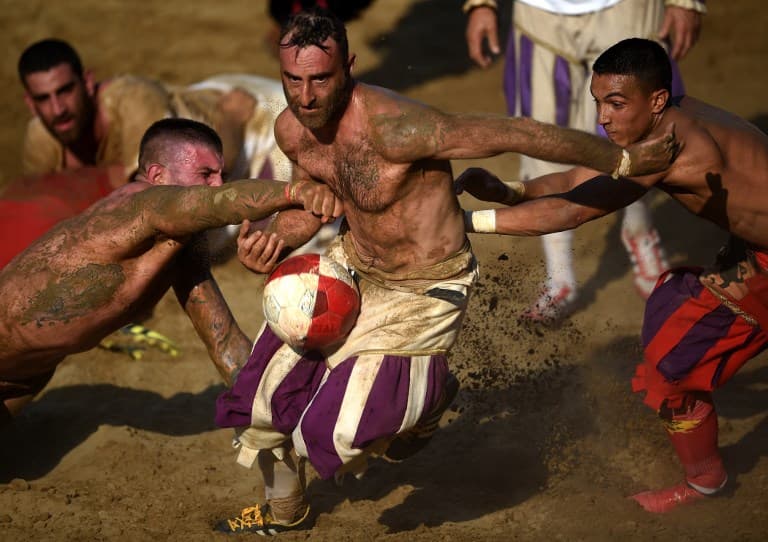
On June 24th each year, Florence's main square turns into an arena for a sport that's a brutal combination of rugby, football, and wrestling. The Local explores the history of this unique tradition.
Calcio Storico (Historical football) is a game thought up by 16th-century Florentines and as the name suggests, it's an early - and very violent - form of football. It was also known as giuoco del calcio fiorentino (Florentine kicking game) and was very popular several centuries ago.
READ ALSO:
-
Thirteen dialect words to help you sound like a local in Florence
-
Where to find great Florentine street food
-
One of Florence's greatest spectacles is about to begin
These days, your only chance to watch a match is in June, when four local teams battle it out in Florence to be crowned the champions. The whole city turns out to enjoy the spectacle.
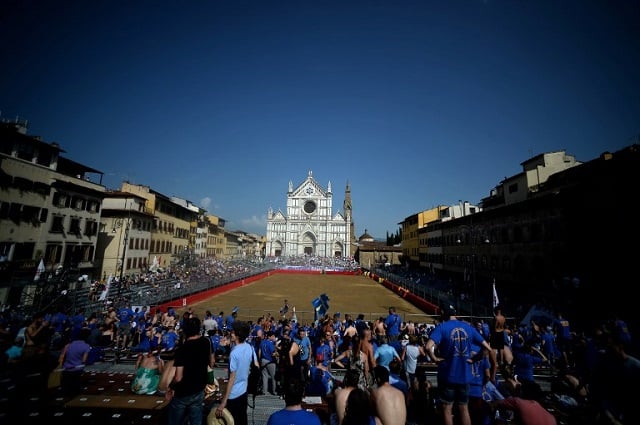
Spectators gathered in Piazza Sante Croce for the game. Photo: Filippo Monteforte/AFP
How do you play?
The game is played on a rectangular field with a length roughly twice as long as the width, and covered with sand. It's divided down the middle into two matching squares, with goal nets at each end.
Two teams of 27 players take part in the matches which last for 50 minutes. No substitutions are allowed, even if there are injuries - which there often are. The ball is thrown into the centre of the pitch, and the teams descend on it in an effort to gain possession and kick it over a fence at the opposing team's end of the field.
Players can use hands and feet and tactics such as tripping and tackling are also admissible, meaning things get pretty violent - though there is a long list of rules aimed at keeping injuries to a minimum, updated from the original version written by a Renaisance count. For example, while many fighting techniques (including martial arts) are allowed, it's not OK for more than one player to attack a single opponent at once.
READ ALSO: Five crazy Italian festivals that no-one should miss
Is it dangerous?
Yes. While there have been no deaths during the game in modern times, there have been numerous cases of players hospitalized, sometimes for months.
City authorities in 2007 banned the match for a year after a brawl which saw around 50 players (that's almost all of them) taken to court. After that, new rules banned convicted criminals from taking part.
Who takes part?
Four teams take part in the Florentine Calcio Storico, each representing a different district of the city: Santa Croce (blue), Santa Maria Novella (red), Santo Spirito (white), and San Giovanni (green). Semi-finals take place early in June, with the pairings decided by drawing coloured balls on Easter Sunday, and the finals are held on June 24th, the feast day of Florence's patron saint, John the Baptist.
In 2014, the rules regarding participation in the tournament were changed, so only people born in Florence or who have lived in the area for at least ten years can take part. Those rule changes also aimed to cut down on violence, for example banning head-to-head clashes.
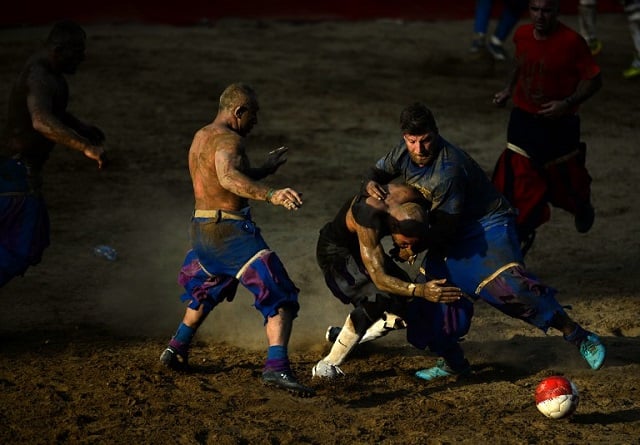
Photo: Filippo Monteforte/AFP
Are there prizes?
Of course! The winning team used to take home a butchered calf, but now they get a free ready-cooked dinner at a restaurant. There's no official prize-giving or medal ceremony - the players play for glory.
So ... why do we celebrate it?
At one time, the game was practiced regularly, and today's match is in part a reenactment of a game played while Florence was under imperial siege. It's held on the city's patron saint's feast day as a celebration of Florentine pride by remembering the defiance of that match.
However, after the 17th-century, it fell out of favour and the tradition seems to have been forgotten for a couple of hundred years. Fascist dictator Benito Mussolini revived the game in the 1930s, promoting it as part of his regime's focus on glorifying Italy's past, and amateur games were held up and down the country.
But now, the only time you'll be able to watch it is in June in Florence.
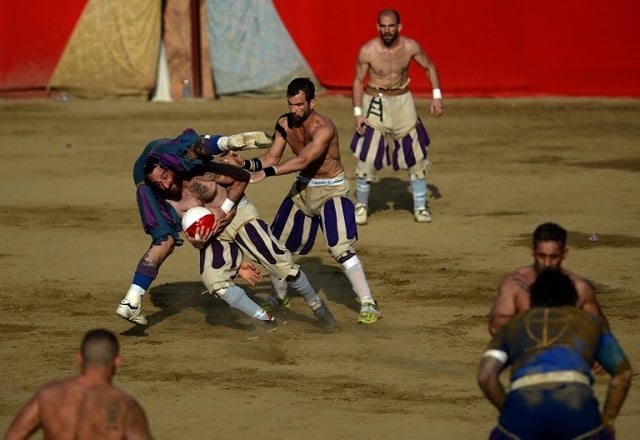
Photo: Filippo Monteforte/AFP
Is there anything else going on?
Yes. Calcio Storico is not just a sporting event but a celebration of Florence, and the day begins with a medieval pageant. Marching bands and costumed people, including Calcio Storico players from each of the four teams, make their way through the city's streets on the way to Piazza Santa Croce.
The final takes place in the late afternoon at around 5pm, so afterwards you can expect a lively atmosphere in Florentine bars and pubs. St John's Day is rounded off with a fireworks display over the River Arno.
Comments
See Also
Calcio Storico (Historical football) is a game thought up by 16th-century Florentines and as the name suggests, it's an early - and very violent - form of football. It was also known as giuoco del calcio fiorentino (Florentine kicking game) and was very popular several centuries ago.
READ ALSO:
- Thirteen dialect words to help you sound like a local in Florence
- Where to find great Florentine street food
- One of Florence's greatest spectacles is about to begin
These days, your only chance to watch a match is in June, when four local teams battle it out in Florence to be crowned the champions. The whole city turns out to enjoy the spectacle.

Spectators gathered in Piazza Sante Croce for the game. Photo: Filippo Monteforte/AFP
How do you play?
The game is played on a rectangular field with a length roughly twice as long as the width, and covered with sand. It's divided down the middle into two matching squares, with goal nets at each end.
Two teams of 27 players take part in the matches which last for 50 minutes. No substitutions are allowed, even if there are injuries - which there often are. The ball is thrown into the centre of the pitch, and the teams descend on it in an effort to gain possession and kick it over a fence at the opposing team's end of the field.
Players can use hands and feet and tactics such as tripping and tackling are also admissible, meaning things get pretty violent - though there is a long list of rules aimed at keeping injuries to a minimum, updated from the original version written by a Renaisance count. For example, while many fighting techniques (including martial arts) are allowed, it's not OK for more than one player to attack a single opponent at once.
READ ALSO: Five crazy Italian festivals that no-one should miss
Yes. While there have been no deaths during the game in modern times, there have been numerous cases of players hospitalized, sometimes for months.
City authorities in 2007 banned the match for a year after a brawl which saw around 50 players (that's almost all of them) taken to court. After that, new rules banned convicted criminals from taking part.
Who takes part?
Four teams take part in the Florentine Calcio Storico, each representing a different district of the city: Santa Croce (blue), Santa Maria Novella (red), Santo Spirito (white), and San Giovanni (green). Semi-finals take place early in June, with the pairings decided by drawing coloured balls on Easter Sunday, and the finals are held on June 24th, the feast day of Florence's patron saint, John the Baptist.
In 2014, the rules regarding participation in the tournament were changed, so only people born in Florence or who have lived in the area for at least ten years can take part. Those rule changes also aimed to cut down on violence, for example banning head-to-head clashes.

Photo: Filippo Monteforte/AFP
Are there prizes?
Of course! The winning team used to take home a butchered calf, but now they get a free ready-cooked dinner at a restaurant. There's no official prize-giving or medal ceremony - the players play for glory.
So ... why do we celebrate it?
At one time, the game was practiced regularly, and today's match is in part a reenactment of a game played while Florence was under imperial siege. It's held on the city's patron saint's feast day as a celebration of Florentine pride by remembering the defiance of that match.
However, after the 17th-century, it fell out of favour and the tradition seems to have been forgotten for a couple of hundred years. Fascist dictator Benito Mussolini revived the game in the 1930s, promoting it as part of his regime's focus on glorifying Italy's past, and amateur games were held up and down the country.
But now, the only time you'll be able to watch it is in June in Florence.

Photo: Filippo Monteforte/AFP
Is there anything else going on?
Yes. Calcio Storico is not just a sporting event but a celebration of Florence, and the day begins with a medieval pageant. Marching bands and costumed people, including Calcio Storico players from each of the four teams, make their way through the city's streets on the way to Piazza Santa Croce.
The final takes place in the late afternoon at around 5pm, so afterwards you can expect a lively atmosphere in Florentine bars and pubs. St John's Day is rounded off with a fireworks display over the River Arno.
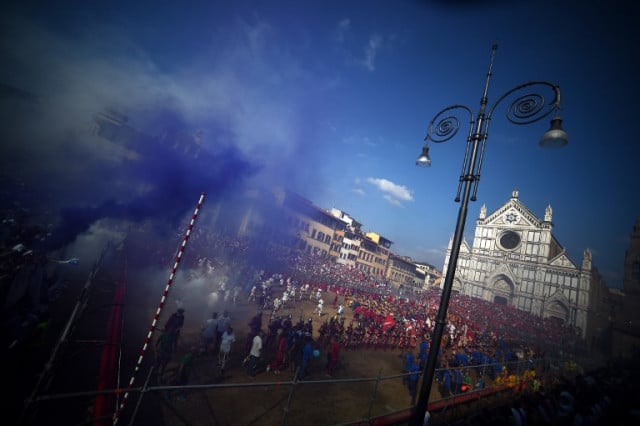
Join the conversation in our comments section below. Share your own views and experience and if you have a question or suggestion for our journalists then email us at [email protected].
Please keep comments civil, constructive and on topic – and make sure to read our terms of use before getting involved.
Please log in here to leave a comment.